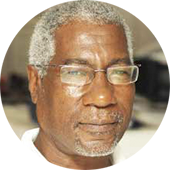
The world is watching the Ukraine war, which has already touched everyone worldwide, if only because of the disastrous effects it’s had on food and fuel prices globally; and Russia continues to be blamed fully for every aspect of the fighting that’s resulted in largescale loss of life and destruction of property.
But, after 46 years following international war correspondents reporting from the battle-ground, the world has also never had such a hard time like now, getting reports from “both sides” involved in this ongoing battle, not only for territory, but also for minds.
The 1983 US-led invasion of Grenada introduced the Caribbean to the role played by the US Central Intelligence Agency (CIA) in arranging the necessary prior psychological war-fare preparations.
Back then, ex-CIA agent Philip Agee and other former agents published the Covert Action Information Bulletin that exposed the CIA’s Psychological Warfare Manual that targets minds of people in the countries to be invaded, feed them with selected images and treated messages.
But in today’s age of 21st Century Information Technology (IT) and Artificial Intelligence (AI), war propaganda has shifted gear to a much-higher stage — this time, not only aimed at people’s eyes and ears, but their brains.
A March 8, 2022 article entitled ‘The Casualties of War’ by Patrick Lawrence, a former in-ternational correspondent for the International Herald Tribune, offers much related food for thought.
Published by Consortium News, it reveals that in January 2021, the North Atlantic Treaty Organization (NATO) – the US-led European military alliance — published the “final draft” of a lengthy study it called “Cognitive Warfare”, aimed at exploring the potential for manipulating minds like never before.
The document says, in part: “The brain will be the battlefield of the 21st century…” and “Humans are the contested domain…” — and therefore, “Cognitive Warfare’s objective is to make everyone a weapon…”
In a subsection headed “The vulnerabilities of the human brain,” the NATO report also said: “In particular, the brain is unable to distinct [sic] whether information is right or wrong and is led to believe statements or messages it has already heard as true, even though these may be false; accepts statements as true, if backed by evidence, with no re-gards to [sic] the authenticity of that evidence.”
It continues: “At the political and strategic level, it would be wrong to underestimate the impact of emotions…” and further, “Emotions — hope, fear, humiliation — shape the world and international relations with the echo-chamber effect of social media.”
Cognitive Warfare unfolds on our TV screens every time we tune to the BBC or CNN for information on the world’s latest war.
On April 11, CNN and BBC quoted Ukraine officials as reporting that “tens of thousands of civilians” have been killed by “tens of thousands of Russians…” – again with no evi-dence shown – and absolutely no news whatsoever about Russians killed in the bombed-out tanks shown, or the fate of Russian soldiers captured.
Censorship is also very-much alive and well in the coverage, as the UK, European Union and USA have all banned broadcasts by RT, the Russian international TV outlet that’s op-erated at great cost for decades (and great benefit to Europe and USA treasuries) through regional and international branches and offices in every major world capital.
In Ukraine, even before the war, President Zelensky has also banned local TV outlets op-posing him or seen as “supporting Russia”.
Today, some 50 days since the war started, fair-minded Caribbean citizens seeking infor-mation from “both sides” simply can’t access RT, including on paid TV channels, as it’s been outed.
As if instructed daily to “Say this, not that…” reports from correspondents across Ukraine are shaped to accept whatever if offered, right or wrong, true or false.
Last weekend, TV reports from Ukraine show images of less than a dozen scattered and sealed “body bags” along an unidentified roadside, allegedly containing “dead civilians with hands tied behind their backs and shot in the head by Russian troops…”
The Russian press has also been reporting, from Moscow, that the bodies claimed to be in bags were actually “taken from hospital morgues” and “planted in mass graves” also claimed to have been dug by “retreating Russians.”
Moscow also says the bomb fragments displayed and claimed to have been used by Rus-sians to bomb a train station “are only used by the Ukrainian army…”
But even before international observers and UN agencies could visit the scenes and verify such reports, the barrage of unverified images and reports had done the job of condi-tioning minds worldwide, resulting in Russia’s expulsion from the UN Human Rights Committee, mostly on the basis of how conditioned minds react to the selected propa-ganda.
Anyone who takes time-off to find out the real history behind the two neighboring na-tions in the current war will better understand why Russia and Ukraine are fighting today, but historical doesn’t matter if they don’t suit today’s NATO, EU or US narrative.
President Biden, having pulled troops out of Afghanistan after two decades unsuccessful-ly trying to unseat the Taliban, will not dare commit American troops to fight for Ukraine on European soil – not ahead of November’s mid-term elections — and is instead en-couraging NATO’s European members to openly funnel arms to Ukraine, with UK Prime Minister Boris Johnson earlier this week visiting Ukraine to pledge and deliver arms from the UK’s large armoury.
Before the Ukraine war, such operations would have been correctly described as a covert operation, but it’s done in broad daylight today, labelled “solidarity with a NATO partner.”
Grown-up with decades of BBC propaganda and living with CNN since the Afghanistan and Iraq wars, I can clearly say that Cognitive Warfare is not only real, but also fully op-erational – and yielding the desired results of “making everyone a weapon…”.
NATO’s Cognitive Warfare is at full blast and the world continues to be blinded — with eyes wide open.












